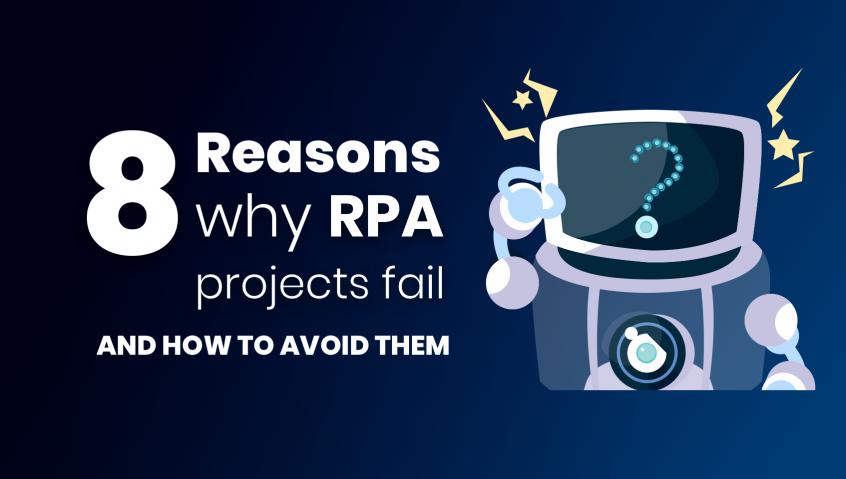
When given a bird’s-eye-view, RPA seems like a fairly simple process to implement. After all, how difficult could it be for a bot to do mundane and tedious tasks? But take a closer look and you’d find several reasons why RPA projects fail and what impact it can create on businesses.
What one needs to know are the potential causes of failure and the ways to avoid it. In this article we will discuss exactly that so that you can mitigate the chances of failure for an RPA project that you might have in the pipeline, ready for implementation.
8 Reasons Why RPA projects fail:
Not picking the right tool
If you go out there looking for an RPA tool right now, you’d find tens of options to pick from, who are all competitive and offer solutions to all your automation problems. But for a successful implementation of an RPA program it is important to identify the problem and get the right tool to solve it. Picking the right tool might require extensive research and deep understanding of what the technology can do to help your business scale. Talk to experts or get trial versions or a PoC whenever possible, before settling for the right RPA product.
Not choosing the right function to automate
Let’s be real, just because you can, doesn’t mean you should! Identifying the right process to automate is a very important stage of automation. Simply put, RPA works best in processes that demand repetitive mundane work and do not need a lot of human intervention. Introducing automation processes into functions that need advanced and critical thinking would invariably fail when attempted to be automated. The RPA implementation will go smooth and just likely to produce good results if the operations have gone through a selection process through the IT, business, and RPA teams that understand the process that needs to be automated.
Poor Governance
RPA implementation might seem like cake-walk, given the wide usage and plethora of options available. Of course, it’s easier than what many may apprehend, but only when coupled with good governance. You must also know that it demands appropriate management and oversight. If the technology is not approached with the right rigor, knowledge, and supporting teams, it would practically be impossible to scale it and get the right kind of ROI.
RPA failing to get the memo
RPA, when implemented, needs instructions. Expecting it to respond to unexpected situations and learning things over a period of time would be a bad assumption. When implementing RPA, make sure to keep into consideration the growth of use cases where RPA has been deployed with an influx of modern technologies. Ensure to keep updating the instructions and trainings for your bots for it not to break and stop responding.
Not testing enough
It is of paramount importance to test the automation project in question to ensure the final output is desirable. When testing, it is easy to miss out on the RPA technology-related functional specifications since it may not be explicitly listed out in the design documents. Your RPA team should include testing as many negative scenarios, if possible.
Unclear RPA strategy
Before you get started on your automation journey, talk to all potential stakeholders and get everyone’s buy-in. More importantly, discuss with your IT team, business analysts, testers, process controllers and business process consultants to build a cohesive RPA strategy right from the first step. Without a proper plan on how RPA is going to be used, your automation business process runs a high risk of becoming a standalone function, working in silos and not benefit the business as expected.
Setting unrealistic expectations
Remember, RPA will automate repetitive and mundane jobs and free up your employees to get more complex tasks done more efficiently. Expecting it to miraculously reform your business and setting up unrealistic expectations might be a mistake. Understand the changes your business will see with automating a process and set realistic targets.
Missing out on measuring the performance
Other than monitoring the robots’ behavior and investigating the exceptions, people often miss out on recording and measuring the automation’s effectiveness. Thus, the RPA team should prepare a list of KPIs to measure and resources dedicated to understand and analyze if the RPA implementation is successful.
Mitigating RPA projects fail-rate
These are just the top reasons of failure of an automation project but are not limited to these. Like how the possibilities of success with an RPA implementation are unlimited, so are the failures. Choose your automation path carefully and be well informed through the entire lifecycle of the project. Getting on the path to RPA is both easy and tricky at the same time.
Qentelli’s Take
Our experts at Qentelli can help you identify these challenges and put you on the right path of automation right from the start. Our wide array of services will not just help you in getting started on your RPA journey, but also mitigate any risks of failure in the process.

